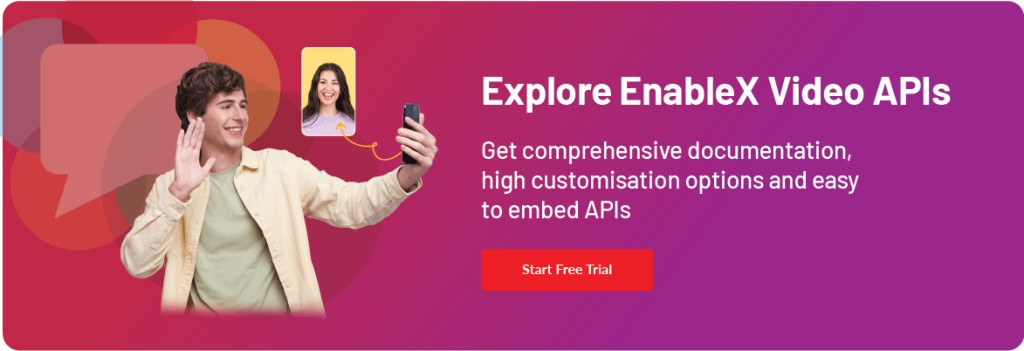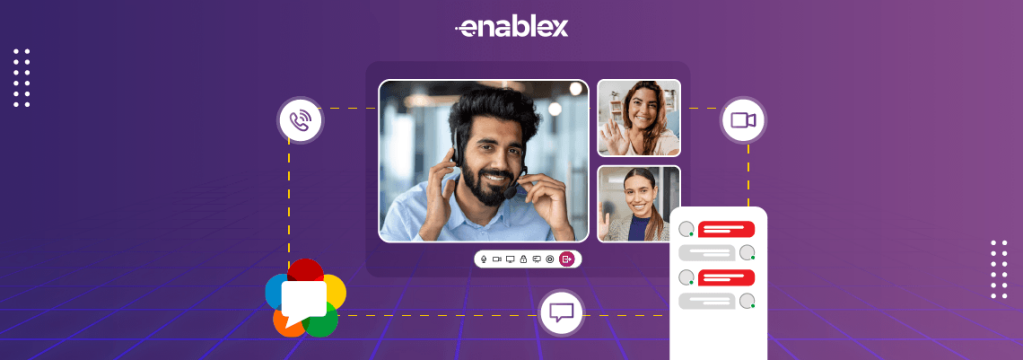WebRTC, which stands for Web Real-Time Communication, is a powerful technology that enables real-time communication between web browsers. Users can make calls, share files, and collaborate on documents without needing extra plugins or software installations. Overall, WebRTC video calling applications help developers build, launch and grow video conferencing solutions with high quality, low cost and easily manageable projects.
What Is WebRTC?
WebRTC, short for Web Real-Time Communication, is an open-source project that provides web browsers and mobile applications with real-time communication (RTC) capabilities via simple APIs (Application Programming Interfaces).
This allows developers to add voice only calling, video calling, and data communication to their web-based applications without the need for any additional plugins or third-party software. Now, to make a video conferencing call, or share a file—all that you need is a URL.
Also read: The Most Comprehensive Guide on WebRTC

Benefits of WebRTC vs competing standards:
- Developers can add various video elements to any website or app, ensuring users can join as remote peers, making WebRTC work for a wide variety of use cases.
- WebRTC enables users to make video chats for both one to one video chats, multi party video conferencing, or even live streaming applications.
- The WebRTC video api is scalable, helping businesses grow their data channels in line with business growth. Providers, such as EnableX, often offer WebRTC pricing on a pay as you grow model, keeping costs in check.
- WebRTC APIs allow adding video and audio tracks separately, enabling seamless joining of calls in different modes.
- WebRTC works well on very low network speeds, helping users in low connectivity areas join calls as required.
The fundamentals of WebRTC
At its core, WebRTC consists of three main components: the getUserMedia API, the RTCPeerConnection API, and the RTCDataChannel API. These building blocks work together seamlessly to provide a smooth and reliable real-time communication experience.
The getUserMedia API is responsible for accessing the user’s media devices, such as the microphone and camera. It allows web applications to capture audio and video streams directly from the user’s device, enabling features like video conferencing and live streaming. With just a few lines of code, developers can easily request access to these media devices and start capturing media in real-time.
The RTCPeerConnection object API is the heart of WebRTC. It establishes a peer-to-peer connection between two or more browsers, allowing them to exchange audio, video, and data streams. This API handles the negotiation and establishment of the connection, as well as the encryption and decryption of the media streams. It also takes care of network traversal, ensuring that the connection can be established even in the presence of firewalls and NAT devices.
The RTCDataChannel API, on the other hand, enables the exchange of arbitrary data between browsers. It provides a reliable, ordered, and bi-directional channel for sending and receiving data. This can be used for various purposes, such as file sharing, multiplayer gaming, or real-time collaboration on documents. The RTCDataChannel API is built on top of the RTCPeerConnection API, leveraging its underlying peer-to-peer connection for efficient data transfer.
In addition to these core components, WebRTC also relies on a signaling mechanism to establish the initial connection between browsers. This signaling mechanism can be implemented using various protocols, such as WebSocket or HTTP. It is responsible for exchanging session descriptions and ICE candidates, which are necessary for the browsers to establish a direct peer-to-peer connection.
Overall, WebRTC provides a powerful and flexible framework for building real-time communication applications directly in the web browser. Its simplicity and ease of use make it an ideal choice for developers looking to add real-time communication capabilities to their web applications. With the basics and components of WebRTC in place, the possibilities for innovative and immersive web experiences are endless.
Key Components of WebRTC
1. getUserMedia API
The journey of a WebRTC session begins with capturing audio and video from the user’s device. The `getUserMedia` API allows developers to access the user’s audio and video devices, such as the webcam and microphone, allowing users to grant or deny permissions for media access. This component ensures that only authorized audio and video inputs are used in a session.
The getUserMedia API is particularly useful for developing web-based applications that need to use the user’s audio and video devices, such as video conferencing applications, VoIP applications, and live streaming applications.
2. RTCPeerConnection
This component is responsible for many intricate tasks within peer-to-peer communication, making it the linchpin of the WebRTC framework. Its functions encompass:
- Initiating and establishing peer-to-peer connections.
- Managing session protocols and ensuring smooth session management.
- Orchestrating the exchange of Session Description Protocol (SDP) messages and overseeing negotiations through ICE candidates, with potential involvement of STUN and TURN for network traversal.
- Real-time encoding and decoding of multimedia streams, including audio, video, and text.
- Addressing various network-related issues, such as bandwidth estimation and packet loss.
3. RTCDataChannel
This API allows developers to send and receive arbitrary data between peers. This component is used in places like online gaming, file sharing, and collaborative applications.
4. Signaling Server
WebRTC does not handle signaling directly; it relies on a signaling server to exchange information between peers. This server helps establish connections, negotiate session parameters, and exchange metadata. While WebRTC itself is peer-to-peer, the signaling server plays a pivotal role in initiating and managing sessions.
The Signaling Server in the context of WebRTC plays a crucial role that the WebRTC framework does not explicitly define. This component facilitates the exchange of SDP (Session Description Protocol) strings and ICE (Interactive Connectivity Establishment) Candidates between two people. Additionally, the Signaling Server is responsible for determining which peers should establish connections with each other.
5. STUN and TURN Servers
WebRTC relies on STUN (Session Traversal Utilities for NAT) and TURN (Traversal Using Relays around NAT) servers for establishing connections. These servers help to establish peer-to-peer connections between devices that are behind firewalls or NAT routers, ensuring that communication can take place even in demanding network environments.
Conclusion
WebRTC is a strong tool for developers to add real-time communication to web and mobile apps, without needing extra plugins.
EnableX platform provides comprehensive documentation, tutorials, and developer resources to assist users in implementing and utilizing its video API effectively. We have a support team to help users with any questions or concerns. The team ensures that users have an easy and trouble-free experience.
EnableX offers a reliable and advanced solution for video, voice, SMS, and WhatsApp communication, benefiting industries like business, telemedicine, and education. It helps organizations effectively utilize the power of video communication.
Sign up for EnableX’s free trial account to experience the best webRTC-based communication solutions available.


